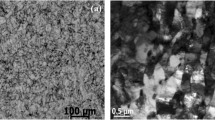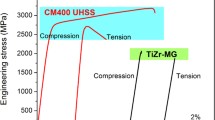Abstract
Fatigue tests were conducted on a series of 1800 MPa-class spring steels whose fatigue properties were inclusion controlled. The fatigue tests were conducted on billets and on hot-rolled bars, taking into account the elongation of the oxide-type composite inclusions that were deformed during hot rolling, i.e., controlled inclusions. Anisotropy of the fatigue properties due to the slender shape of the elongated inclusions was also discussed. Fatigue tests were then conducted for both the rolling direction (RD) and transverse direction (TD) in the case of the billets. The fatigue test results in the RD showed a slight difference between billets and bars. The inclusions that were deformed during hot rolling were sufficiently elongated, even for the billet specimens, and differences in the effective inclusion sizes between the billets and their hot-rolled bars for the RD were small. However, there were marked differences in fatigue strength between the RD and TD in the billet specimens: the fatigue strength was almost half in the TD due to the presence of fish-eye fractures originating in large and slender MnS inclusions. In these fatigue tests, the two types of deformable inclusions revealed remarkably different effects on fatigue strength: the deformable oxide-type inclusions never caused fish-eye fracture, although the MnS inclusions found in the billets were extremely detrimental to fatigue strength when stress was applied in the TD.
Similar content being viewed by others
References
Y. Murakami: Metal Fatigue: Effects of Small Defects and Nonmetallic Inclusions, Elsevier, London, 2002.
S. Nishijima and K. Kanazawa: Fatigue Fract. Eng. Mater. Struct., 1999, vol. 22, pp. 601–07.
K.J. Miller and W.J. O’Donnell: Fatigue Fract. Eng. Mater. Struct., 1999, vol. 22, pp. 545–57.
Y. Murakami, M. Takada, and T. Toriyarna: Int. J. Fatigue, 1998, vol. 16 (9), pp. 661–67.
Y. Furuya, S. Matsuoka, T. Abe, and K. Yamaguchi: Scripta Mater., 2002, vol. 46 (2), pp. 157–62.
Y. Furuya, T. Abe, and S. Matsuoka: Fatigue Fract. Eng. Mater. Struct., 2003, vol. 26, pp. 641–45.
Y. Murakami, T. Toriyama, K. Isubota, and K. Furuyama: ASTM STP1327, ASTM, Philadelphia, PA, 1998.
T. Abe, Y. Furuya, and S. Matsuoka: Fatigue Fract. Eng. Mater. Struct., 2004, vol. 27 (2), pp. 159–67.
T. Abe and S. Matsuoka: Trans. JSSR, 2001, vol. 46, pp. 19–25 (in Japanese).
N.M.A. Eid and P.F. Thomason: Acta. Metall., 1979, vol. 79, pp. 1239–49.
J. Mormot, B. Heritier, and J.Y. Gogne: ASTM STP987, ASTM, Philadelphia, PA, 1988.
L.O. Uhrus: Special Report No. 77, Iron and Steel Institute, 1963, pp. 104–09.
D. Brooksbank and K.W. Andrews: J. Iron Steel Inst., 1972, vol. 210, pp. 246–55.
Y. Furuya and S. Matsuoka: Metall. Mater. Trans. A, 2002, vol. 33A, pp. 3421–31.
L.H. Donnel: in Stress Concentration Factors, R.E. Peterson, ed., John Wiley & Sons, New York, NY, 1974, p. 223.
K. Toyama and Y. Yamarnoto: Proc. Fatigue ’90, 1990, vol. 1, pp. 343–48.
T. Ohshiro, I. Ikeda, H. Matsuyama, S. Okushima, Y. Oki, and N. Ibaraki: Kobelco Technol. Rev., 1987, vol. 2, pp. 36–40.
T. Takahashi: J. Jpn. Soc. Technol. Plast., 1989, vol. 30, pp. 1239–44 (in Japanese).
ASTM Standard, E45, ASTM, Philadelphia, PA, 1997.
E.J. Gumbel: Statistics of Extremes, Columbia University Press, New York, NY, 1957.
JIS Z 2273, JIS Handbook 1-1, Japanese Standards Association, Tokyo, 1997, pp. 178–82 (in Japanese).
Y. Ono, T. Yuri, H. Sumiyoshi, S. Matsuoka, and T. Ogata: Mater. Trans., 2003, vol. 44, pp. 1702–05.
Y. Furuya, S. Matsuoka, and I. Abe: Metall. Mater. Trans. A, 2003. vol. 34A, pp. 2517–26.
Y. Murakami, T. Nomoto, and T. Ueda: Fatigue Fract. Eng. Mater. Struct., 1999, vol. 22, pp. 581–90.
N. Nagashima, S. Matsuoka, and K. Miyahara: Trans. Jpn. Soc. Mech. Eng., 1999, Ser. A, vol. 65 (631), pp. 477–82 (in Japanese).
Author information
Authors and Affiliations
Rights and permissions
About this article
Cite this article
Furuya, Y., Abe, T. & Matsuoka, S. Inclusion-controlled fatigue properties of 1800 MPA-class spring steels. Metall Mater Trans A 35, 3737–3744 (2004). https://doi.org/10.1007/s11661-004-0279-1
Received:
Issue Date:
DOI: https://doi.org/10.1007/s11661-004-0279-1




